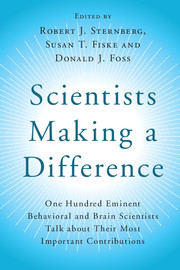 Scientists Making a Difference
Scientists Making a Difference from Section A - Motivation
Published online by Cambridge University Press: 05 August 2016
I started thinking about creativity at the age of five. I overheard my kindergarten teacher, Mrs. Bollier, say to my mother, “I think Teresa shows a lot of potential for artistic creativity, and I hope that's something she really develops over the years.” Thrilled to hear it, I began imagining a life as a creative artist. Unfortunately, kindergarten was the peak of my artistic career. As I later revisited that flashbulb memory, I often wondered what happened to that promised creativity. Maybe Mrs. Bollier was wrong; I had no artistic talent. But maybe the cause had something to do with my art experiences in the ensuing elementary school years, when artistic activities, limited to one hour on Friday afternoons, consisted of trying to copy various great masterworks in painting. Limited to a few broken crayons and notebook paper, my classmates and I received no skill training; giving it my all, I nonetheless produced monstrosities that consistently earned poor grades. It was decades before I again felt like doing any sort of art.
The mystery of my missing artistic creativity receded into the background as I entered Canisius College, a small liberal arts school, as a chemistry major. I loved each science to which I'd been exposed, and chose chemistry because it looked excitingly challenging. I did well academically and, more importantly, had the opportunity to work in the labs of several research-active chemistry professors. (My first publication was in The Journal of Chromatographic Science.) In the summer after my second year, though, I had a life crisis. Impressed with the passion that my professors had for chemistry – I'd noticed the paper napkins covered with benzene rings and equations that they'd leave on the table after their intense lunch conversations – I realized I didn't enjoy thinking about chemistry on my own time. I didn't have that passion and doubted I ever would. But I wanted to find something that could captivate me that way.
I did find that something, the following year, when I took introductory psychology as an elective. The textbook, long since a classic, was by Ernest Hilgard and Richard Atkinson; the professors were Harvey Pines and Dewey Bayer.
To save this book to your Kindle, first ensure no-reply@cambridge.org is added to your Approved Personal Document E-mail List under your Personal Document Settings on the Manage Your Content and Devices page of your Amazon account. Then enter the ‘name’ part of your Kindle email address below. Find out more about saving to your Kindle.
Note you can select to save to either the @free.kindle.com or @kindle.com variations. ‘@free.kindle.com’ emails are free but can only be saved to your device when it is connected to wi-fi. ‘@kindle.com’ emails can be delivered even when you are not connected to wi-fi, but note that service fees apply.
Find out more about the Kindle Personal Document Service.
To save content items to your account, please confirm that you agree to abide by our usage policies. If this is the first time you use this feature, you will be asked to authorise Cambridge Core to connect with your account. Find out more about saving content to Dropbox.
To save content items to your account, please confirm that you agree to abide by our usage policies. If this is the first time you use this feature, you will be asked to authorise Cambridge Core to connect with your account. Find out more about saving content to Google Drive.